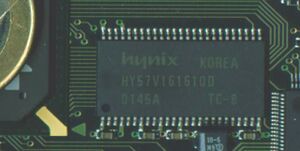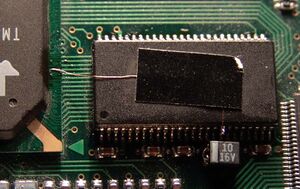Memory Mod
Introduction
The idea to this modification was introduced by Oliver Endriss.
The Idea
Full-featured DVB cards are equipped a 2 MByte SDRAM chip. Using the Linux DVB driver, OSD memory space is limited to approx. 80 KByte. Therefore, it is not possible to have a full-screen, 256 color OSD with VDR. But the AV7110/7111 is able to handle two of these chips allowing the full-screen 256 color OSD. Additional there would be more space for the video buffers. Why not add the second one?
The Modification
The chip select for the second SDRAM chip is not available on the pcb itself, so the processor AV7110 and the memory chip have to be modified.
Here you can see both chips before the modification. On the left hand side the processor, the complete visible chip is the SDRAM memory chip. As a size comparison you see a 1EURO coin. For the Mod you have to scratch one of the thin lines on the processor until the protective coating is removed and solder a thin wire on it. Then a second SDRAM chip has to be soldered on top of the existing one. For this you have to carefully bend the pins. Connect all pins 1:1 to the first SDRAM, except pin 18 (/ChipSelect). This pin 18 has to be connected to the thin wire of the processor. With an extended Firmware the processor can use the full 4Mbyte.
Image of the modified DVB board:
- Step1: carefully bend the pins of the new sdram chip, i.e. by pressing the chip on a surface. You have to bend all pins except pin 18 CS (the 8th pin of the bottom lne, starting from the right). Have a look at the picture.
- Step2: solder the second SDRAM chip onto the top of the existing one. Solder the pins of the new chip on the pins of the old one. Ensure that you have all pins connected and no short circuits.
- Step3: carefully scratch through the protective coating of the AV7110 to get the coating removed from the wire. As you can see at the picture there are 6 round areas, the wire beneath the sixth with the small step is the one we need. Please do not scratch deeply as it would make it impossible to solder on that line. If you see the copper shining it's enough.
- Step4: soldering ot the line
- Step5: Connect it to the pin 18 of the sdram. Use a very thin wire of approx 0.1mm diameter.
- Step6: Fix the thin wire and check the connection again
List of suitable SDRAM chips
This list may be imcomplete. The AV711x needs 3.3Volt IO-Ports, therefore a 3.3Volt SDRAM in TSOPII packaging is needed. Some of that chips are on old graphics boards.
| Producer | Part Name | Informations |
| ESMT/EliteMT | M12L16161A-7T | homepage datasheet |
| EtronTech | EM636165TS-8 | homepage datasheet |
| Samsung | K4S161622E-TC80 | homepage datasheet |
| Goldstar | GM72V161621 |
Software Requirements
DVB driver with 4MB support (Firmware 261c or newer)
Links
| [1] | vdrwiki:osdtest256-plugin | Plugin for testing of modded cards |
| [2] | vdrwiki:text2skin-plugin | plugin for loading of skins |
| [3] | http://www.rightchoiceelectronics.com/cr.html | Reference list with different ICs. Needed: 1Mx16 SDRAMs. |
| [4] | http://www.pcstats.com/ramfinder.cfm | RamFinder - Infos about RAM-ICs |
| [5] | http://www.wolfsoft.de | DVB Card Upgrade 2MB->4MB (~45 Euro) bzw. SDRAM (5,00+9,70)Euro |


